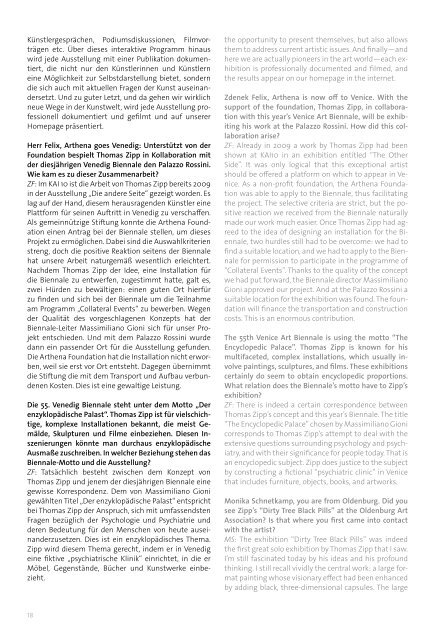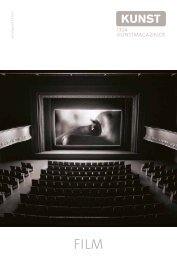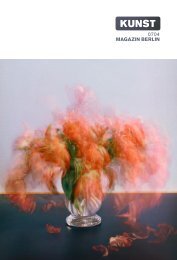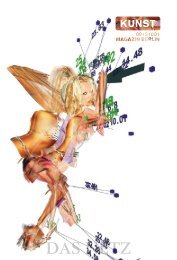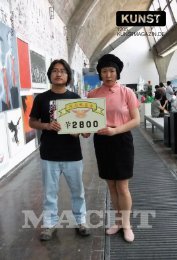Download als .pdf - KUNST Magazin
Download als .pdf - KUNST Magazin
Download als .pdf - KUNST Magazin
Erfolgreiche ePaper selbst erstellen
Machen Sie aus Ihren PDF Publikationen ein blätterbares Flipbook mit unserer einzigartigen Google optimierten e-Paper Software.
Künstlergesprächen, Podiumsdiskussionen, Filmvorträgen<br />
etc. Über dieses interaktive Programm hinaus<br />
wird jede Ausstellung mit einer Publikation dokumentiert,<br />
die nicht nur den Künstlerinnen und Künstlern<br />
eine Möglichkeit zur Selbstdarstellung bietet, sondern<br />
die sich auch mit aktuellen Fragen der Kunst auseinandersetzt.<br />
Und zu guter Letzt, und da gehen wir wirklich<br />
neue Wege in der Kunstwelt, wird jede Ausstellung professionell<br />
dokumentiert und gefilmt und auf unserer<br />
Homepage präsentiert.<br />
Herr Felix, Arthena goes Venedig: Unterstützt von der<br />
Foundation bespielt Thomas Zipp in Kollaboration mit<br />
der diesjährigen Venedig Biennale den Palazzo Rossini.<br />
Wie kam es zu dieser Zusammenarbeit?<br />
ZF: Im KAI 10 ist die Arbeit von Thomas Zipp bereits 2009<br />
in der Ausstellung „Die andere Seite“ gezeigt worden. Es<br />
lag auf der Hand, diesem herausragenden Künstler eine<br />
Plattform für seinen Auftritt in Venedig zu verschaffen.<br />
Als gemeinnützige Stiftung konnte die Arthena Foundation<br />
einen Antrag bei der Biennale stellen, um dieses<br />
Projekt zu ermöglichen. Dabei sind die Auswahlkriterien<br />
streng, doch die positive Reaktion seitens der Biennale<br />
hat unsere Arbeit naturgemäß wesentlich erleichtert.<br />
Nachdem Thomas Zipp der Idee, eine Installation für<br />
die Biennale zu entwerfen, zugestimmt hatte, galt es,<br />
zwei Hürden zu bewältigen: einen guten Ort hierfür<br />
zu finden und sich bei der Biennale um die Teilnahme<br />
am Programm „Collateral Events“ zu bewerben. Wegen<br />
der Qualität des vorgeschlagenen Konzepts hat der<br />
Biennale-Leiter Massimiliano Gioni sich für unser Projekt<br />
entschieden. Und mit dem Palazzo Rossini wurde<br />
dann ein passender Ort für die Ausstellung gefunden.<br />
Die Arthena Foundation hat die Installation nicht erworben,<br />
weil sie erst vor Ort entsteht. Dagegen übernimmt<br />
die Stiftung die mit dem Transport und Aufbau verbundenen<br />
Kosten. Dies ist eine gewaltige Leistung.<br />
Die 55. Venedig Biennale steht unter dem Motto „Der<br />
enzyklopädische Palast“. Thomas Zipp ist für vielschichtige,<br />
komplexe Installationen bekannt, die meist Gemälde,<br />
Skulpturen und Filme einbeziehen. Diesen Inszenierungen<br />
könnte man durchaus enzyklopädische<br />
Ausmaße zuschreiben. In welcher Beziehung stehen das<br />
Biennale-Motto und die Ausstellung?<br />
ZF: Tatsächlich besteht zwischen dem Konzept von<br />
Thomas Zipp und jenem der diesjährigen Biennale eine<br />
gewisse Korrespondenz. Dem von Massimiliano Gioni<br />
gewählten Titel „Der enzyklopädische Palast“ entspricht<br />
bei Thomas Zipp der Anspruch, sich mit umfassendsten<br />
Fragen bezüglich der Psychologie und Psychiatrie und<br />
deren Bedeutung für den Menschen von heute auseinanderzusetzen.<br />
Dies ist ein enzyklopädisches Thema.<br />
Zipp wird diesem Thema gerecht, indem er in Venedig<br />
eine fiktive „psychiatrische Klinik“ einrichtet, in die er<br />
Möbel, Gegenstände, Bücher und Kunstwerke einbezieht.<br />
the opportunity to present themselves, but <strong>als</strong>o allows<br />
them to address current artistic issues. And finally—and<br />
here we are actually pioneers in the art world—each exhibition<br />
is professionally documented and filmed, and<br />
the results appear on our homepage in the internet.<br />
Zdenek Felix, Arthena is now off to Venice. With the<br />
support of the foundation, Thomas Zipp, in collaboration<br />
with this year’s Venice Art Biennale, will be exhibiting<br />
his work at the Palazzo Rossini. How did this collaboration<br />
arise?<br />
ZF: Already in 2009 a work by Thomas Zipp had been<br />
shown at KAI10 in an exhibition entitled “The Other<br />
Side”. It was only logical that this exceptional artist<br />
should be offered a platform on which to appear in Venice.<br />
As a non-profit foundation, the Arthena Foundation<br />
was able to apply to the Biennale, thus facilitating<br />
the project. The selective criteria are strict, but the positive<br />
reaction we received from the Biennale naturally<br />
made our work much easier. Once Thomas Zipp had agreed<br />
to the idea of designing an installation for the Biennale,<br />
two hurdles still had to be overcome: we had to<br />
find a suitable location, and we had to apply to the Biennale<br />
for permission to participate in the programme of<br />
“Collateral Events”. Thanks to the quality of the concept<br />
we had put forward, the Biennale director Massimiliano<br />
Gioni approved our project. And at the Palazzo Rossini a<br />
suitable location for the exhibition was found. The foundation<br />
will finance the transportation and construction<br />
costs. This is an enormous contribution.<br />
The 55th Venice Art Biennale is using the motto “The<br />
Encyclopedic Palace”. Thomas Zipp is known for his<br />
multifaceted, complex installations, which usually involve<br />
paintings, sculptures, and films. These exhibitions<br />
certainly do seem to obtain encyclopedic proportions.<br />
What relation does the Biennale’s motto have to Zipp’s<br />
exhibition?<br />
ZF: There is indeed a certain correspondence between<br />
Thomas Zipp’s concept and this year’s Biennale. The title<br />
“The Encyclopedic Palace” chosen by Massimiliano Gioni<br />
corresponds to Thomas Zipp’s attempt to deal with the<br />
extensive questions surrounding psychology and psychiatry,<br />
and with their significance for people today. That is<br />
an encyclopedic subject. Zipp does justice to the subject<br />
by constructing a fictional “psychiatric clinic” in Venice<br />
that includes furniture, objects, books, and artworks.<br />
Monika Schnetkamp, you are from Oldenburg. Did you<br />
see Zipp’s “Dirty Tree Black Pills” at the Oldenburg Art<br />
Association? Is that where you first came into contact<br />
with the artist?<br />
MS: The exhibition “Dirty Tree Black Pills” was indeed<br />
the first great solo exhibition by Thomas Zipp that I saw.<br />
I’m still fascinated today by his ideas and his profound<br />
thinking. I still recall vividly the central work: a large format<br />
painting whose visionary effect had been enhanced<br />
by adding black, three-dimensional capsules. The large<br />
Frau Schnetkamp, Sie stammen aus Oldenburg. Haben<br />
Sie Zipps „Dirty Tree Black Pills“ im Oldenburger Kunstverein<br />
gesehen? Ist bereits dort ein erster Kontakt zum<br />
Künstler entstanden?<br />
MS: Die Ausstellung „Dirty Tree Black Pills“ war wirklich<br />
die erste große Solo-Ausstellung von Thomas Zipp, die<br />
ich gesehen habe. Von seinen Ideen und tiefgründigen<br />
Gedankengängen bin ich bis heute fasziniert. Ich erinnere<br />
mich noch gut an die zentrale Arbeit, ein großformatiges<br />
Gemälde, dessen visionäre Wirkung noch durch<br />
die Hinzufügung von schwarzen dreidimensionalen<br />
Kapseln zusätzlich gesteigert wurde. Die spätere große<br />
Einzelausstellung im Museum Fridericianum 2010<br />
mit dem Titel „mens sana in corpore sano“ („Ein gesunder<br />
Geist in einem gesunden Körper“), in der Zipp das<br />
gesamte Gebäude in eine psychiatrische Klinik verwandelte,<br />
hat mich nachhaltig beeindruckt. Mithilfe von<br />
eingebauten langen Gängen, die wirkliche, aber auch<br />
imaginäre Wände aufwiesen und denen mysteriöse Türen<br />
beigefügt wurden, schuf Zipp eine Art Parcours, dem<br />
wir <strong>als</strong> Besucher folgen konnten. Auf suggestive Art und<br />
Weise vermittelte dieser Rundgang Vorstellungen einer<br />
„geschlossenen Anstalt“ mit Bibliothek, Gummizellen,<br />
Behandlungsräumen etc. Diese bedrückende Inszenierung<br />
lud zum Nachdenken darüber ein, was „normal“<br />
und was „verrückt“ ist und wo die Grenzen zwischen der<br />
„heilen“ und „kranken“ Welt zu ziehen sind.<br />
Thomas Zipps Installation im Palazzo Rossini trägt den<br />
Titel „Comparative investigation about the disposition<br />
of the width of a circle“. Damit bezieht sich Zipp u. a.<br />
auf den „l´arc de cercle“, einen Begriff, der im Rahmen<br />
der Hysterieforschung Ende des 19. Jh. in der berühmten<br />
Salpêtrière in Paris geprägt wurde. Auch für Venedig<br />
entwirft Zipp, wie Sie ja schon ausführten, Herr Felix,<br />
eine fiktive Forschungsanstalt, inklusive Schlafraum,<br />
Bibliothek u. a. Inwiefern wird sich diese Konzeption<br />
von der Kasseler Installation unterscheiden? Oder ist<br />
das, was Zipp für Venedig plant, <strong>als</strong> Weiterentwicklung<br />
von „(White Reformation Co-Op)“ zu verstehen?<br />
ZF: Die Inszenierung in Venedig wird gewissermaßen den<br />
Grundgedanken der Kasseler Ausstellung von Zipp weiterführen,<br />
doch diese Thematik auf eine andere Ebene<br />
heben. Die Inszenierungen von Thomas Zipp zeichnen<br />
sich immer durch ein hohes Maß an Individualität und<br />
Eigenständigkeit aus. Er bringt stets neue Gedanken<br />
hervor, die es erlauben, seine Werke jeweils in einem<br />
neuen Kontext zu sehen. Zipp ist ein veritabler Entdecker<br />
und Erfinder.<br />
Wir danken Ihnen vielm<strong>als</strong> für das Gespräch!<br />
solo exhibition entitled “Mens sana in corpore sano”<br />
(“A healthy mind in a healthy body”) at the Museum<br />
Fridericianum in 2010, during which Zipp transformed<br />
the entire building into a psychiatric clinic, left a lasting<br />
impression on me. By constructing long corridors,<br />
which had both real as well as imaginary walls, to which<br />
mysterious doors had been added, Zipp created a sort<br />
of parcours we could follow as visitors. In a suggestive<br />
manner, this pathway conjured up impressions of a<br />
“closed facility” with a library, padded rooms, examination<br />
rooms, and so on. This oppressive work invited us<br />
to reflect upon what’s “normal” and what’s “crazy” and<br />
where the borders between the “sane” and the “sick”<br />
world are to be drawn.<br />
Thomas Zipp’s installation at the Palazzo Rossini is entitled:<br />
“Comparative Investigation about the Disposition<br />
of the Width of a Circle”. Zipp is thus <strong>als</strong>o referring to<br />
the “arc de cercle”—a term used in research on hysteria<br />
at the end of the nineteenth century at the famous<br />
Salpêtrière in Paris. As you already noted, Mr Felix, Zipp<br />
has <strong>als</strong>o designed a fictional research facility that <strong>als</strong>o<br />
includes a sleeping area and a library. How will this conception<br />
differ from the installation in Kassel? Or is what<br />
Zipp has planned for Venice a further development of<br />
his “(White Reformation Co-Op)”?<br />
ZF: The exhibit in Venice will expand upon some of<br />
Zipp’s basic ideas from the exhibition in Kassel, but the<br />
subject has been raised to another level. Thomas Zipp’s<br />
installations are always characterised by a large degree<br />
of individuality and independence. He is always creating<br />
new ideas that allow us to seen his works in their own<br />
new context. Zipp is a veritable discoverer and inventor.<br />
Thank you for the conversation!<br />
18<br />
19


